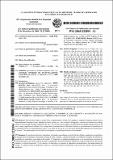Por favor, use este identificador para citar o enlazar a este item:
http://hdl.handle.net/10261/33932COMPARTIR / EXPORTAR:
 SHARE
BASE SHARE
BASE
|
|
| Visualizar otros formatos: MARC | Dublin Core | RDF | ORE | MODS | METS | DIDL | DATACITE | |

| Campo DC | Valor | Lengua/Idioma |
|---|---|---|
| dc.contributor.author | Pons Rovira, José Luis | - |
| dc.contributor.author | Rocón, Eduardo | - |
| dc.contributor.author | Calderón Estévez, Leopoldo | - |
| dc.contributor.author | Ceres Ruiz, Ramón | - |
| dc.date.accessioned | 2011-03-30T09:46:49Z | - |
| dc.date.available | 2011-03-30T09:46:49Z | - |
| dc.date.issued | 2005-12-29 | - |
| dc.identifier.citation | WO 2005/122894 Al | es_ES |
| dc.identifier.uri | http://hdl.handle.net/10261/33932 | - |
| dc.description | Fecha de presentación internacional: 10.06.2005. - Titular: Consejo Superior de Investigaciones Científicas (CSIC) | es_ES |
| dc.description.abstract | [EN] The invention relates to an electronic computing device which, when applied to a digital or analogue signal from an input peripheral (computer mouse, wheelchair control system, etc.), can be used to distinguish a voluntary movement from shaking caused by neurological disorders suffered by the user. The inventive device adapts automatically to the specific characteristics of the user's tremor, regardless of whether it is a resting tremor (characteristic of Parkinson's disease), a postural tremor (characteristic of an essential tremor) or a kinetic/intention tremor. As a result, the device does not have to be specifically adapted to the characteristics of the user. The output signal from the device corresponds to a pathological-tremor-free command. | es_ES |
| dc.description.abstract | [ES] Se trata de un dispositivo electrónico-informático que aplicado a la señal eléctrica digital o analógica de un periférico de entrada (ratón de ordenador, sistema de comando de sillas de ruedas ... ) permite discernir el movimiento voluntario del tembloroso producido por desordenes neurológicos del usuario. El dispositivo se adapta automáticamente a las características concretas del temblor del usuario, sea este un temblor de reposo (característico de la enfermedad de Parkinson), postural (característico del temblor esencial) o cinético/intencional. Por lo descrito, el dispositivo no requiere la adaptación particularizada a las características del usuario. La señal de salida del dispositivo objeto de la presente invención corresponde a una acción de comando libre de temblor patológico. | es_ES |
| dc.language.iso | spa | es_ES |
| dc.rights | openAccess | es_ES |
| dc.title | Method and electronic computing device for suppressing and evaluating tremors and spastic movements in relation to input and control peripherals | es_ES |
| dc.title.alternative | Método y dispositivo electrónico e informático de supresión y valoración de temblor y movimiento espástico en periféricos de entrada y de mando | es_ES |
| dc.type | patente | es_ES |
| dc.description.peerreviewed | Peer reviewed | es_ES |
| dc.type.coar | http://purl.org/coar/resource_type/c_15cd | es_ES |
| item.openairetype | patente | - |
| item.grantfulltext | open | - |
| item.cerifentitytype | Publications | - |
| item.openairecristype | http://purl.org/coar/resource_type/c_18cf | - |
| item.fulltext | With Fulltext | - |
| item.languageiso639-1 | es | - |
| Aparece en las colecciones: | (IAI) Patentes | |
Ficheros en este ítem:
| Fichero | Descripción | Tamaño | Formato | |
|---|---|---|---|---|
| WO2005122894A1.pdf | 1,11 MB | Adobe PDF |  Visualizar/Abrir |
CORE Recommender
Page view(s)
312
checked on 18-abr-2024
Download(s)
107
checked on 18-abr-2024
Google ScholarTM
Check
NOTA: Los ítems de Digital.CSIC están protegidos por copyright, con todos los derechos reservados, a menos que se indique lo contrario.
